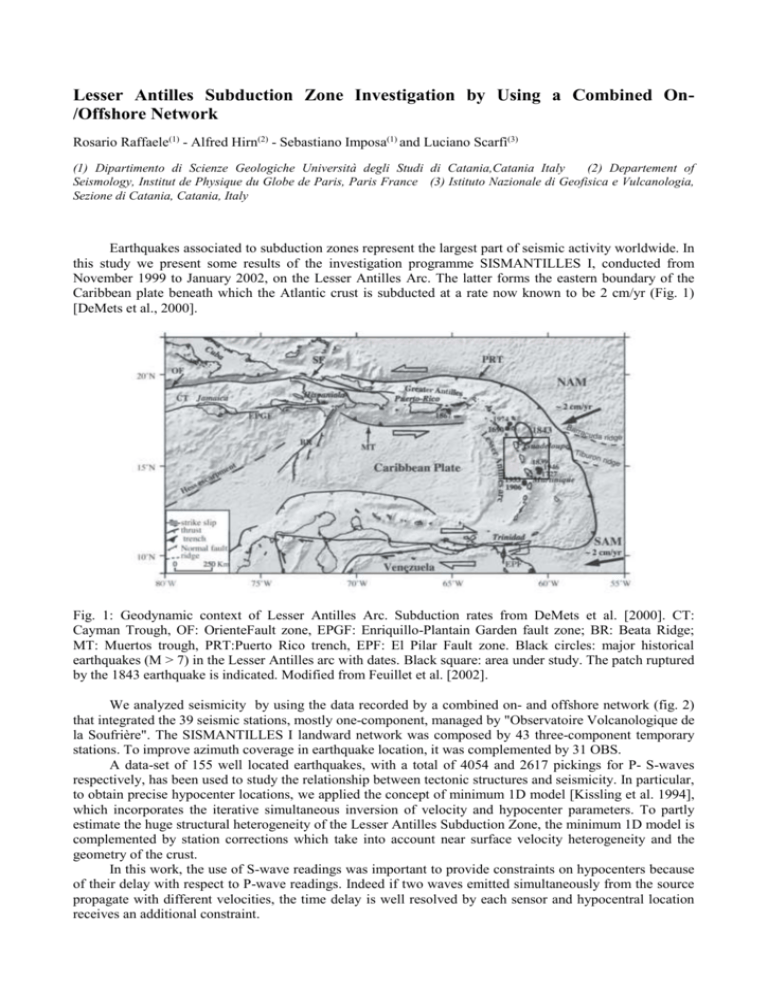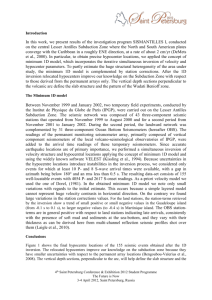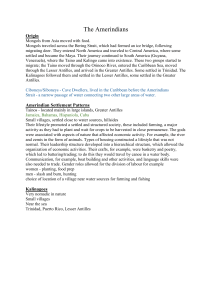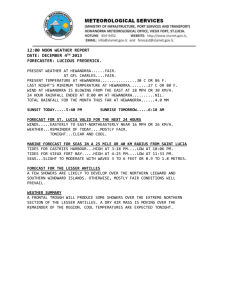View/Open - Earth-Prints Repository
advertisement

Lesser Antilles Subduction Zone Investigation by Using a Combined On/Offshore Network Rosario Raffaele(1) - Alfred Hirn(2) - Sebastiano Imposa(1) and Luciano Scarfì(3) (1) Dipartimento di Scienze Geologiche Università degli Studi di Catania,Catania Italy (2) Departement of Seismology, Institut de Physique du Globe de Paris, Paris France (3) Istituto Nazionale di Geofisica e Vulcanologia, Sezione di Catania, Catania, Italy Earthquakes associated to subduction zones represent the largest part of seismic activity worldwide. In this study we present some results of the investigation programme SISMANTILLES I, conducted from November 1999 to January 2002, on the Lesser Antilles Arc. The latter forms the eastern boundary of the Caribbean plate beneath which the Atlantic crust is subducted at a rate now known to be 2 cm/yr (Fig. 1) [DeMets et al., 2000]. Fig. 1: Geodynamic context of Lesser Antilles Arc. Subduction rates from DeMets et al. [2000]. CT: Cayman Trough, OF: OrienteFault zone, EPGF: Enriquillo-Plantain Garden fault zone; BR: Beata Ridge; MT: Muertos trough, PRT:Puerto Rico trench, EPF: El Pilar Fault zone. Black circles: major historical earthquakes (M > 7) in the Lesser Antilles arc with dates. Black square: area under study. The patch ruptured by the 1843 earthquake is indicated. Modified from Feuillet et al. [2002]. We analyzed seismicity by using the data recorded by a combined on- and offshore network (fig. 2) that integrated the 39 seismic stations, mostly one-component, managed by "Observatoire Volcanologique de la Soufrière". The SISMANTILLES I landward network was composed by 43 three-component temporary stations. To improve azimuth coverage in earthquake location, it was complemented by 31 OBS. A data-set of 155 well located earthquakes, with a total of 4054 and 2617 pickings for P- S-waves respectively, has been used to study the relationship between tectonic structures and seismicity. In particular, to obtain precise hypocenter locations, we applied the concept of minimum 1D model [Kissling et al. 1994], which incorporates the iterative simultaneous inversion of velocity and hypocenter parameters. To partly estimate the huge structural heterogeneity of the Lesser Antilles Subduction Zone, the minimum 1D model is complemented by station corrections which take into account near surface velocity heterogeneity and the geometry of the crust. In this work, the use of S-wave readings was important to provide constraints on hypocenters because of their delay with respect to P-wave readings. Indeed if two waves emitted simultaneously from the source propagate with different velocities, the time delay is well resolved by each sensor and hypocentral location receives an additional constraint. Relocated hypocenters after the 1D inversion are showed in fig. 2. They improve our knowledge on the subduction zone because they have smaller uncertainties with respect to the locations of "Observatoire Volcanologique de la Soufrière". The vertical depth sections perpendicular to the arc define the slab structure and the pattern of the Wadati Benioff zone. For further studies, a P & S tomography local earthquake data will bring more constraints on the structure of Lesser Antilles Arc. Fig. 2: Accurate hypocenters (black circles) as determined by a1D inversion using a combined on-/offshore network. On the right: three vertical depth sections perpendicular to the arc show the hypocenter distribution. Blue triangles stations run by "Observatoire Volcanologique de la Soufrière". Red triangles: temporary landward stations. OBS are marked by red circles. References DeMets, C., Jansma, P. E., Mattioli, G. S., Dixon T. H., Farina, F., Bilham, R., Calais, E. and Mann, P., (2000). GPS geodetic constraints on Caribbean-North America plate motion. Geophysical Research Letters, 27, 437-440. Feuillet, N., Manighetti, I., Tapponnier, P and Jacques, E., (2002). Arc parallel extension and localization of volcani ccomplexes in Guadeloupe, Lesser Antilles. Journal of Geophysical Research, 107, 2 ,331-2,360. Kissling, E., Ellworth W.L., Eberhart-Phillips D. and Kradolfer U., (1994). Initial reference models in local earthquake tomography. Journal of Geophysical Research, 99, 19,635-19,646.











